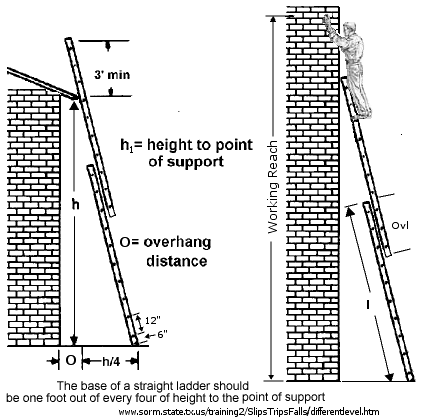Under Construction 
Extension Ladders
Type:
| TYPE | DUTY RATING | WORKING LOAD |
| IAA | Industrial | Special duty 375 lbs. maximum |
| IA | Industrial | extra heavy 300 lbs. maximum |
| I | Industrial | heavy 250 lbs. maximum |
| II | Commercial | medium 225 lbs. maximum |
| III | Household | light 200 lbs. maximum |
A well-made fiberglass ladder shares aluminum's strength and durability, and has the added advantage of being non-conductive and therefore safe to use around electricity. Fiberglass's disadvantage is that the ladder is at least half again as heavy as an aluminum ladder of the same length.
Nominal
length | Working
length | Working
reach | Price | Rental
/day |
| 200# | 250# |
| 24 | 20.5 | 24 | $147 | |
| 28 | 24.5 | 27.8 | | |
| 32 | 28.5 | 31.7 | | | $30 |
| 36 | 32.5 | 35.5 | | | |
| 40 | 35.5 | 38.5 | | | $40 |
| 48 | 43.5 | 46.4 | | | $50 |

Length Overlap
≤ 36' 3'
37-48' 4'
Nominal Length (L) = l * 2
Working Reach = (L - Ovl - 2.5) * .97 + 6
where L = nominal length
Ovl = Overlap
2.5 = Distance of 3rd rung from the top
.97 is adjustment for lean.
6' is reach of 5' 6" person
The working length is the nominal length less the overlap between ladder sections less the distance from the rung to the end.
The actual working height takes into account the highest safe step on which a worker may stand, and the minimum safe angle of lean.
The bottom of the ladder should be 1 foot away from the wall for every 4 feet that the ladder rises. For example, if the ladder touches the wall 16 feet above the ground, the feet of the ladder should be 4 feet from the wall.
Never stand above the third rung (some say 4th rung) from the top and never climb above the point where the ladder touches the wall or vertical support.
Features:
gravity-spring locks: the "bird-beak" locks that support the upper section (the "fly") move out of the way as you raise the ladder, but clamp securely as you bring it back down the base section.
rope and pulley: a nylon rope for one-person extension of the ladder; the rope ties off to one of the steps (there is no rope on the 16-foot ladder)
interlocking rails: the fly section has guides to keep it square with the base section as it's raised
D-rungs: D-shaped aluminum rungs with the ridged flat side up make the steps more slip-resistant
Slip-resistant Base show plate: the base pad is reversible, giving you a spur side for added traction on soft surfaces or a non-slip rubber pad for added traction on smooth surfaces.
Mar-resistant end caps: Nylon inserts into the ends of the base and fly section reduce (but do not eliminate) scrapes and scratches on the supporting surface.
A cherry picker which extends to 36' on wheels that you can tow behind your vehicle rents for $195/day.
Use Guidelines (U. Waterloo):
- Clean off your boot soles before climbing.
- Maintain 3-point contact while climbing or working-- two hands and one foot or two feet and one hand at all times.
If your work requires you to use both hands, a rolling stair, power lift or scaffold is to be used.
- Face the ladder.
- Keep your body between the side rails.
- Keep ladders away from powerlines.
- Don't lean out beyond the side rails.
- Don't carry tools or equipment in your hands while climbing.
- On an extension ladder, stand no higher than the fourth rung from the top.
(CDC Ladder Safety says: "Never stand on the two top rungs of a ladder.")
- Never straddle the space between a ladder and another point.
- When using a ladder to access another level, it must extend at leas 3 ft above the landing or floor.
Falls cause approximately 34 percent of all construction workplace fatalities, the number one killer of construction workers!
Ladder Safety at CDC
OSHA Specs
Extension Ladder Safety and Setup
Simple Ladder-Safety Tips at ThisOldHouse.com
Portable Ladders U. of Waterloo
Climb it safe at American Academy of Orthopaedic Surgeons.
Return to Home & Garden
last updated 4 Nov 2006
| 
